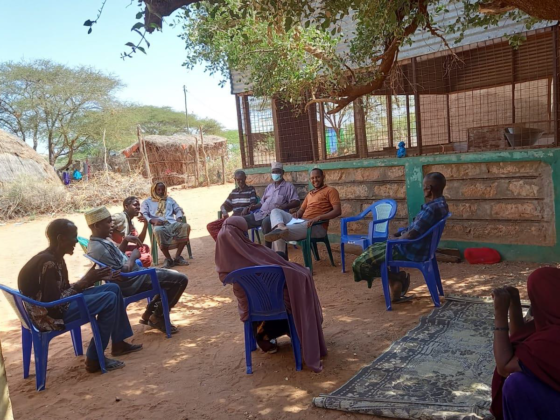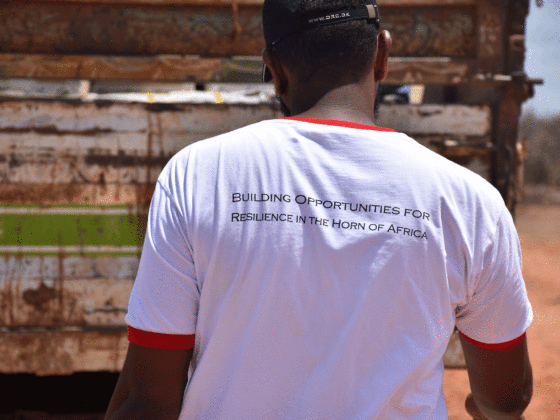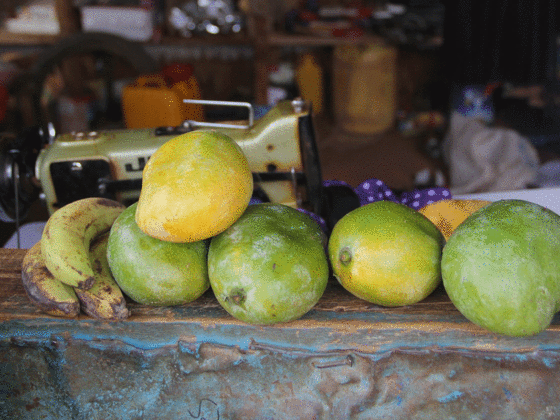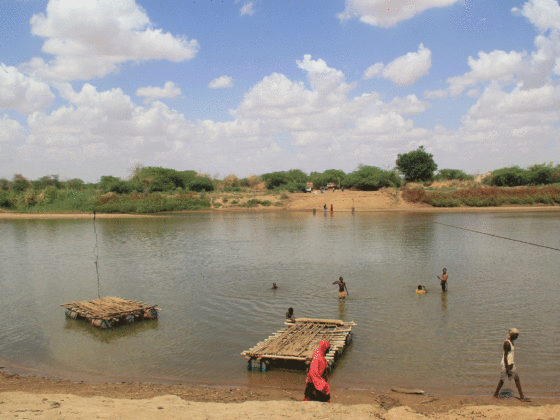RESEARCH & STUDIES

BORESHA III END OF PROJECT EVALUATION SUMMARY BRIEF
Building Opportunities for Resilience in the Horn of Africa III (BORESHA III) is a 5.2 million Euro project funded by the European Union Trust Fund for Africa. The project was implemented for 15 months by the Danish Refugee Council in partnership with World Vision International and CARE International between January 2022 to March 2023 in the Cross-Border area of Kenya, Somalia, and Ethiopia, known as the “Mandera triangle”. The project adopted a community-driven approach to address the shared nature of the risks and opportunities in the target area. The project targeted 350,000 individual beneficiaries across the three countries by making individuals and communities more resilient and better prepared for shocks, more self-reliant through increased skills and opportunities and ensuring equitable and sustainable management of shared natural resources.
The main objective of the end-line evaluation was to provide the end-line status of project outcomes compared to the targets and capture the impact guided by the OECD/DAC criteria. The end-line evaluation used the collaborative outcomes reporting (COR) approach to develop a performance story. The end line evaluation involved quantitative and qualitative approaches largely in line with the OECD/DAC criteria that included Effectiveness and Efficiency, Coherence, Coordination, Impact and Sustainability, and Lessons learnt. The task was undertaken using mixed evaluation/research methodologies in a holistic and integrated manner that included: (i) Desktop research -literature search and file/document review; (ii) key informant interviews and focus group discussions (48).
The main objective of the end-line evaluation was to provide the end-line status of project outcomes compared to the targets and capture the impact guided by the OECD/DAC criteria. The end-line evaluation used the collaborative outcomes reporting (COR) approach to develop a performance story. The end line evaluation involved quantitative and qualitative approaches largely in line with the OECD/DAC criteria that included Effectiveness and Efficiency, Coherence, Coordination, Impact and Sustainability, and Lessons learnt. The task was undertaken using mixed evaluation/research methodologies in a holistic and integrated manner that included: (i) Desktop research -literature search and file/document review; (ii) key informant interviews and focus group discussions (48).

MAPPING STUDY (VALUE CHAIN ANALYSIS) ON COMMERCIALIZATION OF PROSOPIS JULIFLORA IN MANDERA COUNTY
The Building Opportunities for Resilience in the Horn of Africa (BORESHA) project was a cross-border intervention targeting community NRM management in the Mandera Triangle which covered parts of Kenya, Ethiopia and Somalia. The project was led by a consortium led by Danish Refugee Council (DRC) and comprising of CARE International, WYG and World Vision International (WVI). Under the BORESHA Consortium, CARE International was taking the lead in cross border rangeland and other shared natural resources programming to ensure they are equitably and sustainably managed. BORESHA’s project’s commitment to innovation and CARE Kenya as an agency is keen to experiment and adopt new technologies and approaches that solve real life problems that enhance economic self-reliance from environmental sound technologies that use available natural and human resources. In line with this focus, BORESHA undertook a comprehensive assessment to chart a viable pathway for commercial exploitation of Prosopis Juliflora in Mandera. The main objective of the study was to undertake a comprehensive assessment to chart a viable pathway for commercial exploitation of Prosopis Juliflora in Mandera County.

BORESHA II END OF PROJECT EVALUATION SUMMARY REPORT
Building Opportunities for Resilience in the Horn of Africa II (BORESHA II) is a 3,157,896 million Euro project funded by the European Union Trust Fund for Africa. The project was implemented for 10 months by the Danish Refugee Council in partnership with World Vision International and CARE International between March to December 2021 in the Cross-Border area of Kenya, Somalia, and Ethiopia, known as the “Mandera triangle”. The project adopted a community-driven approach to address the shared nature of the risks and opportunities in the target area. The project targeted 350,000 individual beneficiaries across the three countries by making individuals and communities more resilient and better prepared for shocks, more self-reliant through increased skills and opportunities and ensuring equitable and sustainable management of shared natural resources.
The main objective of the end-line evaluation was to provide the end-line status of project outcomes compared to the targets and capture the impact guided by the OECD/DAC criteria. The end-line evaluation used the collaborative outcomes reporting (COR) approach to develop a performance story. The end line evaluation involved quantitative and qualitative approaches largely in line with the OECD/DAC criteria that included Effectiveness and Efficiency, Coherence, Coordination, Impact and Sustainability, and Lessons learnt. The task was undertaken using mixed evaluation/research methodologies in a holistic and integrated manner that included: (i) Desktop research -literature search and file/document review; (ii) key informant interviews (98) and focus group discussions (48).
The main objective of the end-line evaluation was to provide the end-line status of project outcomes compared to the targets and capture the impact guided by the OECD/DAC criteria. The end-line evaluation used the collaborative outcomes reporting (COR) approach to develop a performance story. The end line evaluation involved quantitative and qualitative approaches largely in line with the OECD/DAC criteria that included Effectiveness and Efficiency, Coherence, Coordination, Impact and Sustainability, and Lessons learnt. The task was undertaken using mixed evaluation/research methodologies in a holistic and integrated manner that included: (i) Desktop research -literature search and file/document review; (ii) key informant interviews (98) and focus group discussions (48).

ASSESSMENT OF AGROVETS AND PERCEPTION OF LIVESTOCK HERDERS TOWARDS ANIMAL HEALTH INPUTS IN MANDERA COUNTY
Across Mandera County, livestock is a critical sector that contributes to 72% of the household incomes, employs a large proportion of the population. Although the population depends on livestock, the production and productivity of livestock are very low due to erratic rainfall, poor commercialization, and limited access and use of livestock inputs. The sector receives limited investments from both the private sector and the county government. As the Building Opportunities for Resilience in the Horn of Africa (BORESHA) project promotes economic development and greater resilience, particularly among vulnerable groups in the Mandera Triangle (area between Kenya, Somalia and Ethiopia), it sought to better understand the animal health input market in Mandera County to strengthen the inputs market systems in the Mandera County to bring about the desired sustainable economic development.
The assessment of agrovets and perceptions of livestock keepers towards animal health inputs was carried in the seven sub-counties of Mandera to find out the existing agrovets or private pharmacists existing in the project areas, identify the existing trained Extension Animal Health Workers and their training needs in Mandera County. The assessment covered a range of issues, including the supply side of the inputs market (identifying, mapping and assessing capacities of different actors), demand side of the market (livestock keepers’ willingness and buying decision process for inputs), and the regulatory and enabling environment for animal health inputs in the market. During the assessment, a total of 23 actors were interviewed, 7 focus groups discussions held with a total of 32 livestock producers in the sub-counties, and visits to 12 agrovets across the county.
The assessment of agrovets and perceptions of livestock keepers towards animal health inputs was carried in the seven sub-counties of Mandera to find out the existing agrovets or private pharmacists existing in the project areas, identify the existing trained Extension Animal Health Workers and their training needs in Mandera County. The assessment covered a range of issues, including the supply side of the inputs market (identifying, mapping and assessing capacities of different actors), demand side of the market (livestock keepers’ willingness and buying decision process for inputs), and the regulatory and enabling environment for animal health inputs in the market. During the assessment, a total of 23 actors were interviewed, 7 focus groups discussions held with a total of 32 livestock producers in the sub-counties, and visits to 12 agrovets across the county.

A BORESHA Policy Study on Cross Border Trade .
Cross border trade (CBT) has become increasingly important across the continent as demonstrated by the signing of the Africa Free Continental Trade Area (AfCFTA) agreement. However, due to several challenges, much of the cross-border trade happens informally – outside the framework of state or REC regulations. Previously, informal cross border trade has gone largely unrecognized and efforts to formalize it have been underfunded by governments or attempts have been made to criminalise it. This despite the significant potential that cross border trade holds in contributing to tax collection, supporting income generation, food security, as well as the employment and empowerment of women who constitute a majority of traders in some value chains. It is also a lifeline for food and essential goods for communities living in remote or conflict affected areas. The low level of recognition is partly due to the lack of data on actual volumes of goods that are sold across the border informally. This translates to underreporting on the potential benefits of the cross-border trade to government tax collection efforts and to the welfare of border communities.

SUMMARY REPORT FOR THE END-LINE EVALUATION OF BUILDING OPPORTUNITIES FOR RESILIENCE IN THE HORN OF AFRICA BORESHA PROJECT
The BORESHA project was found to be largely successful in meeting its objectives of promoting economic development and greater resilience among vulnerable groups in the borderlands of Kenya, Somalia, and Ethiopia. The project’s End line evaluation results showed that the project was relevant to the borderlands’ needs at the time of intervention. Several other surveys done by BORESHA during its design and implementation, guided on the areas of intervention, by identifying the immediate needs of the community. The project was also flexible to adapt to changes during the project implementation, which was evident after the onset of Covid-19 which caused many disruptions to the project activities. The project was able to adapt and also re-design the project plans to have interventions aimed at mitigating the effects of Covid-19. Feedback from different stakeholders also helped shape the project design at the initial stages, to make the project more inclusive and consultative with the local stakeholders. There was evidence of enhanced knowledge on early warning signs for common disasters, with the respondents reporting better management of shocks. In total, respondents reported to have managed 56% of the shocks that had occurred one year preceding the survey in a better way (Kenya – 54%, Ethiopia – 57%, Somalia – 58%). In summary, 1,532 beneficiaries were trained on early warning systems. 2,055 goats were also distributed to the beneficiaries, benefitting 411 households. The project also aided in the formation of 37 Disaster Risk Reduction (DRR) plans, out of which 16 were prioritized and integrated into local government plans and/or funded.
Download Poster

BASELINE SURVEY-BUILDING OPPORTUNITIES FOR RESILIENCE IN THE HORN OF AFRICA (BORESHA) PROGRAM - FINAL REPORT
Building Opportunities for Resilience in the Horn of Africa is a multi-country program in Kenya, Ethiopia and Somalia that is to be implemented for a period of three years with funding from European Union Trust Fund for Africa. The program is being implemented by a consortium of partners namely: Danish Refugee Council (DRC) which is the lead partner, CARE Deutschland-Luxemburg (CARE), World Vision UK (WVUK) and WYG International Limited (WYG). The consortium is united by the overall vision of building resilient communities in the Horn of Africa through cross-border programming.The main aim of the program is to create greater economic and employment opportunities and thereby strengthen resilience of communities. The program seeks to achieve these objectives through the following broad intervention areas: Strengthening cross-border communities’ capacities to identify their own priorities, plan and advocate for measures to help them withstand shocks; Promoting the development of inclusive cross-border environment for livestock and non-livestock trade and business, and fostering private sector opportunities for women and young people; Supporting the equitable and conflict sensitive management of natural resources in the cross-border area.
Download Summary

VALUE CHAIN ANALYSIS ON LIVESTOCK, LIVESTOCK PRODUCTS AND ALTERNATIVE LIVELIHOODS IN THE CROSS-BORDER AREA BETWEEN KENYA, ETHIOPIA AND SOMALIA
The value chain analysis on livestock, livestock products and alternative livelihoods assessment in the cross border area between Kenya, Ethiopia and Somalia was commissioned to provide WYG and BORESHA consortium partners’ with proper understanding of the livestock and livestock products value chains to inform strategy for building self-reliant and resilient pastoral communities in the project area.
The findings of this assessment will shed more light on the status and viability of existing and potential markets. The analysis will further determine the value chains that hold promise of employment opportunities, product expansion, market and linkage opportunities, and quality improvement. Results of the study will inform the existing opportunities to promote economic and private sector development and greater resilience in the livestock value chains, with the ultimate aim of achieving self-reliance among the selected communities or individuals through enhanced skills, creation of opportunities for cross border employment and diversified enterprises and livelihoods.
Download Summary

LABOUR MARKET ASSESSMENT IN THE CROSS-BORDER AREA BETWEEN KENYA, ETHIOPIA AND SOMALIA
The target region is an area where the countries of Kenya, Ethiopia, and Somalia meet. The Kenyan side is represented by Mandera town which is the capital of Mandera county in the former North Eastern province of Kenya. Mandera is inhibited by Garreh, Murulle, Degodia, and other smaller tribes. The Ethiopian side is represented by the Suftu, also known as Malka suftu, which is one of the three towns in the Dolo Odo district of Ethiopia. The town is inhibited by Somalis from the Degodia and Garreh of Ethiopia. The Somali of the Triangle are represented by Beled Hawk (Hawo city) formerly Bula Hawo (Hawo village). This city has grown rapidly and is the second largest city in Gedo, the largest province in Somalia.The three borderlands have suffered from the impact of a long civil war in Somalia, violent extremism in the region, inter-clan warfare and frequent drought. In the early 1980s, Beled Hawo in Somalia was the business and development capital of the region. It was a hub for business and trade, an entertainment centre and tourist attraction. Then the town was connected to electricity while Mandera and Suftu were in darkness. War has reversed all such indicators of development and, currently, the three border regions revolve around the Kenyan town of Mandera, which has become the focal point.
Download Summary

MAPPING OF KEY NATURAL RESOURCES IN THE CROSS-BORDER AREAS OF KENYA, SOMALIA & ETHIOPIA
This NRM Mapping study was carried out as part of the inception phase of the BORESHA project so as to develop a number of GIS layers of the areas targeted by the project. These included Infrastructure: mapping key features (roads, rivers, mountains, urban centers, refugee camps); Water resources and infrastructure: existing resources water resources/sources, (dry season wells, rivers, boreholes); an infrastructure potential map to inform the 3R approach of Recharge, Retention and Reuse; Land cover and land use: wet and dry season grazing areas including dry season reserves, key land use types and vegetation types; Resource use and management: document resource uses and management, traditional systems of natural resource and management (NRM) in the area; Human and livestock mobility: patterns of mobility (livestock and people) within and outside the area, and NRM related problems: document any significant NRM related problems and issues.. The study was conducted in the cross-border area comprising
Download Summary

Boresha: A snapshot of cross-border traders
The cross-border region at the intersection of the Kenya, Somalia and Ethiopia border represents a vibrant space of economic activity. The BORESHA project conducted exploratory data collection to understand the borderland region’s local conditions for economic and private sector development, and for indicators that would contribute to resilience, particularly among vulnerable groups. This data report focuses on businesses based in the BORESHA target areas of Mandera County in Kenya, Gedo Region in Somalia, and Dolow Ado District in Ethiopia. In addition to outlining the attributes of the region’s businesses, we employed a needs-based analysis of the information environment. This analysis focused on understanding businesses’ operations, their preferences and challenges related to accessing relevant business information, and potential avenues for future interventions. This report’s objective is to convey the key differences in business interactions and information accessibility to inform the development of information platforms that provide accessible and relevant business information to the region. The findings suggest a significant diversity of experiences related to the border area, between women and men, and age groups working in the crossborder context. Understanding this diversity will be essential for interventions seeking to impact economic development in the Ethiopia-Kenya-Somalia border region.
